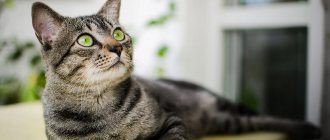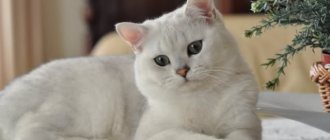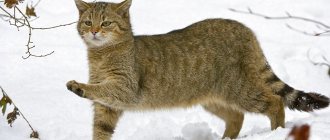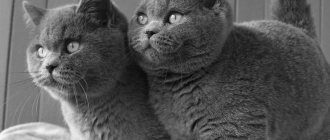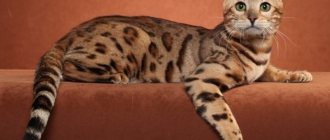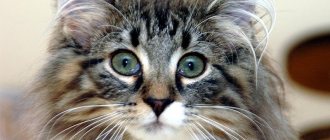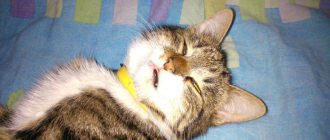The European short-haired cat, otherwise called the Celtic cat, has its own special features that distinguish it from other cats of various breeds.
Her amazing hunting instincts, the gracefulness visible in every movement of the animal, the grace with which she moves, attract everyone's attention and adoration to her.
Cats of this breed were the first to cross the threshold of a human home. The ancestors of Europeans quickly got used to man and began to listen to him.
History of the origin of European Shorthair cats
These cats do not have an origin that would be worthy of being recorded in legends. This animal was born as a result of selection over the domestic European.
This was first done by scientists from Germany, who presented one of these short-haired cats at an exhibition in 1938.
The beautiful specimen immediately attracted the attention of both the French and the British, who had long been trying to improve the existing breed. They wanted to add some new features to the animal, but the results of such experiments were completely different breeds - British and Chartreaux.
This breed itself was later bred by Danish, Norwegian and Swedish scientists. It was registered in 1948, but had too many similarities with the British. The varieties were separated almost at the end of the twentieth century, and only in 1981 a breed standard was formed and recognized.
Description of European Shorthair cats
There are certain features and differences by which European shorthair cats :
- The head is medium sized, round and wide:
- straight nose;
- medium-sized ears with possible tufts at the tips;
- wide-set and somewhat slanted eyes. Their color matches the color of the coat.
- These animals are small only in childhood. As they grow, they turn into large and massive pets.
The paws of Europeans are powerful, but not short, and the paws themselves are round and plump.
The tail is wide, tapering towards the end.
The Celtic cat can weigh up to eight kilograms.
- The coat of the European Shorthair is shiny, dense and silky.
- If we talk about color, it’s easier to say which colors you definitely won’t find in these Europeans: chocolate, lilac, cinnamon, fawn and acromelanic shades. But a white , or any other European shorthair cat can easily be found.
Description of the breed
The European Shorthair cat is distinguished by the stable transmission of traits to offspring. A description of the breed in accordance with established standards will help to distinguish a representative of the European Shorthair from an ordinary domestic cat.
| Established breed standards | |
| Head | Relatively large head. It is slightly longer than wide, which visually makes it round. The skull and forehead are rounded. The nose is uniformly wide, straight, and medium in length. The cheeks are pronounced. Strong, well defined chin. The neck is short and full, muscular. |
| Ears | The length of the ears is approximately equal to the width of the ear at the base, the ears are located straight and far from each other. Medium size, triangular in shape, slightly rounded and often with tassels. |
| Eyes | Round in shape, bright and large eyes, slightly angled and widely spaced. The color of the iris depends on the color of the coat; can be golden, orange, copper, yellow, blue or green. Heterochromia is possible. |
| Body | The proportions are respected, not short, with well-developed muscles. The chest is round and pronounced, the back is strong. |
| Paws | Round, small and dense. The legs themselves are strong. |
| Tail | Medium length, with a thicker base and a narrow, rounded end. |
| Size | 18-25 cm |
| Weight | 4-8 kg |
Colors
Nowadays, breeders are trying to breed short-haired cats of rare colors, so that almost any type of color is possible: blue, tortoiseshell, snow-white, red, silver, smoky. In total, there are about 50 types of colors in the standard.
Various patterns are common: spotted, brindle, marbled, as well as tabby, which is also called wild color.
Photos of European cats
Personality of European Shorthair cats
By nature, the European Shorthair cat is a very calm and gentle creature. If she came to the house for the first time, she may be shy and hide, but she will soon get used to the new environment.
The main features of the character of such a pet are energy, love of games, and fun. These pets will not require too much attention to themselves; they will calmly be alone for some time, having fun on their own.
Another interesting fact: when Europeans are nervous, they blush. Their nose, ears and paws instantly turn red. In addition, at this moment they may also sweat.
They will never rush at a person, will not show aggression, scratch or bite. Therefore, Celtic European Shorthair cats are ideal for families with children.
The wonderful sociable disposition, excellent sharp mind and good manners that a European has had since childhood will give reason to actively admire such a pet.
Character
The character of Celtic cats is not the simplest, they are proud, stubborn, freedom-loving, self-sufficient and independent, they communicate only with those people who treat them with respect and do not allow themselves commands and humiliation towards them. Cats that walk on their own are about this breed. These animals are endowed with excellent intelligence, which allows them to solve problems that are difficult for other cats.
Living next to a person has not deprived the European Shorthair of hunting instincts; if there is no opportunity to walk and catch rodents, then flies and other insects that get into the home become victims. These cats are very active, playful and inquisitive, exploring something all the time, and occasionally sitting quietly or sleeping. These cats are laconic; they meow only in rare cases when they really need something.
Among family members, these pets choose one owner, copying his manners and habits, adopting his daily routine, and can even watch TV next to him. But obsession is not their quality, they do not need increased attention, and they tolerate loneliness well. They love their owner, but they feel like they are equal with him, they keep their feelings deep within themselves and show them only occasionally. These cats prefer to hide from strangers in the house. Celtic cats are aggressive towards other animals in the house, especially dogs, so it is better to keep such a cat alone.
One of the features of these animals is their excellent adaptive abilities; they can survive in any conditions. Another advantage is their neatness and cleanliness; they do not tend to spoil household items and furniture. But it is desirable that toys be freely available, especially those with moving mechanisms.
Caring for European Shorthair cats
Celtic cats do not require any special care. In addition, they may pretend that they do not need their owner's attention at all, although this is definitely not the case. They cannot clean their own ears or trim their nails, and they are unlikely to be able to bathe on their own.
Experts say that these cats do not need to be bathed often. Once every six months is more than enough.
Frequent bathing will immediately affect your pet's fur, it will become degreased, and the hairs will begin to break. Therefore, systematic water procedures should be replaced with regular combing.
Hygiene procedures and pet appearance
If a short-haired pet does not participate in any competitions and lives at home in an apartment, it should be bathed as rarely as possible.
Keeping the breed is simple and does not require large expenses, since the coat is short and there is no large undercoat, heavy shedding does not occur. You can comb it once a week.
If a short-haired pet does not participate in any competitions and lives at home in an apartment, it should be bathed as rarely as possible.
It is advisable to clean your eyes and ears as needed with cotton pads soaked in water. If you walk your cat outside, you need to check the inside of the ears and wipe them with 3% hydrogen peroxide for prevention.
Reviews of European Shorthair cats
- Alice.
I have three cats , and until recently I thought they were outbred, and then I found out that one of them belongs to the European Shorthair . She has her own wonderful character, she is tame and very affectionate, she cannot sleep without me. A little gluttonous.
- Olesya.
My European Shorthair cat 's name is Leia, and even from the photo you can see that she bears a resemblance to this princess. She has a tortoiseshell color.
She is gentle and often acts like a little kitten. He can play around, purrs often and even heals. He lies down next to the sore spot, and after a while it becomes much easier.
- Igor.
After we moved, we immediately took two Europeans into the house. They are friendly and energetic. Every evening the house is happy because of their games. We love them.
History of the breed
The European Shorthair was created by breeding from an ordinary domestic cat. Specialists from France, England and Germany began breed selection. Representatives of each country were interested in something different about the breed.
The British preferred cats with round heads and large, squat bodies. As a result, the world was introduced to a now popular cat breed – the British Shorthair. French felinologists obtained a breed called Chartreux, which is very similar to the British one.
The European cat breed was the result of the work of Scandinavian specialists. The first European shorthair cat was registered under the name “Swedish Shorthair” back in the middle of the 20th century.
At first, the European Shorthair was perceived as one of the varieties of the British breed. So it was only in 1982 that the European Shorthair breed standard was officially approved by the International Cat Federation.
Health and feeding of European shorthair cats
These animals do not have serious genetic diseases. To prevent them from getting other diseases that cats usually get, they must be vaccinated.
Even if the pet does not leave the apartment and always sits at home, it can get sick, because there is dirt in the house, which we carry on clothes, shoes and even on our hands.
The lifespan of the European Shorthair is from fifteen to seventeen years.
You can feed a European with both prepared food and natural food. The main thing is not to make portions too large and remember that thirty percent of the diet should consist of meat.
It is forbidden to give your pet milk, fish and sweets.
If you want to get a devoted but independent companion who will not be afraid of temporary loneliness, the European Shorthair cat is for you!
Care and maintenance
The European Shorthair breed does not require specific care; a minimum number of actions are required from owners.
It is advisable to comb your smooth-haired pet 1-2 times a week. This will get rid of lost hair and improve blood circulation. Frequent washing is not recommended - the procedure can damage the hair follicles; it will be enough to bathe once every six months.
It is worth cleaning your ears as they become dirty. A rather large ear, poorly protected by fur, easily collects dust and earwax inside. For cleaning, cotton swabs or disks moistened with a special solution or hydrogen peroxide are suitable. Under no circumstances should you go deep into the ear - you only need to remove dirt from the visible surface.
Regular oral care is necessary. Special devices have been created for cleaning cat teeth: brushes and toothpastes. However, you can get by by including solid foods in your diet.
Nail trimming is required a couple of times a month. It is necessary to cut off only the colorless part, otherwise there is a high probability of damage to the pulp, which subsequently leads to complications. Cats also need a scratching post. If your pet often spends time outside, then a haircut may not be necessary.
Diet
The European can eat both natural food and industrial feed.
When choosing a natural diet, it is necessary to take into account that the diet should consist of 80% protein foods. Such products include eggs, some dairy products, lean meat and fish, which are often prohibited to be given, otherwise there is a risk of developing urolithiasis. Also, you should not include milk in the diet - the cat’s digestive system does not absorb it. From dairy products you can give fermented baked milk, cottage cheese, sour cream. You should add boiled vegetables and various cereals to your food.
If preference is given to feed, then everything is much simpler: feed is selected taking into account the weight and age, characteristics of the animal’s body. High-quality food must contain all the minerals, vitamins and nutrients necessary for cat health. It is better to choose dry food, occasionally adding wet food to the diet.
European shorthair cat. Photo
5 / 5 ( 1 voice )


